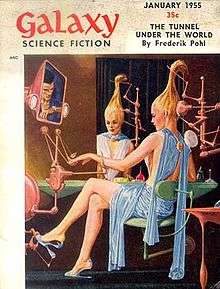The Tunnel under the World

"The Tunnel under the World" is a science fiction short story by American writer Frederik Pohl. It was first published in 1955 in Galaxy magazine. It has often been anthologised, appearing among the others in The Golden Age of Science Fiction, edited by Kingsley Amis (1981).
Plot
Guy and Mary Burckhardt wake up in their house in Tylerton on June 15, having both had terrible nightmares, but they cannot recall the events of their dreams. Guy dismisses the dream and goes to work as usual, the downtown offices of Contro Chemicals, which operates a highly automated and robot-staffed petrochemicals plant. But something is not right; he is surrounded everywhere by loud and all-pervasive advertising jingles for everything from cigarettes to freezers.
A colleague named Swanson tries to speak to him but apparently does not get the desired reaction from Burckhardt and leaves. Burckhardt goes home, but the next morning, when he wakes up, he is had the same nightmare and the date is still June 15. He knows what will happen when he gets to the office and that Swanson will again try to speak to him. This in fact happens.
That evening, Burckhardt discovers that his cellar has seemingly been dismantled and "rebuilt", in a way he does not recognise. And the next morning, again it is June 15, although he knows it cannot be. He mentions this when Swanson again tries to speak to him. Swanson hustles him away to the empty halls of the chemical plant. Hiding in a room at the end of a long tunnel, he explains his theory that they have all been tampered with and that an invader has taken over the town for unknown reasons.
But neither of them are correct. It transpires that the chemical plant exploded. All the inhabitants of Tylerton were killed by the explosion or the chemical fumes. Dorchin, a ruthless advertising executive, took over the whole ruins and rebuilt them in miniature. The people were rebuilt as minuscule robots, and are being used as captive subjects for testing high-pressure advertising campaigns.
TV and film versions
Over the years, the story has been adapted for several media, including:
- A 1956 radio adaptation, "Tunnel Under the World", was broadcast as an episode of X Minus One.
- It was produced by the BBC as a 1966 series 2 episode of the anthology series Out of the Unknown.
- The story was the basis for the Italian surrealist film, Il tunnel sotto il mondo (1969).[1]
- The story inspired the French student short film, Le 15 Mai (1969), the directorial debut of Claire Denis.
References
External links
- The Tunnel Under The World at Project Gutenberg
- The Tunnel under the World title listing at the Internet Speculative Fiction Database
- Author's home page
- Author's entry at NNDB
- X Minus One Episode at the Internet Archive
-
 The Tunnel Under The World public domain audiobook at LibriVox
The Tunnel Under The World public domain audiobook at LibriVox